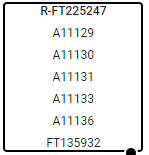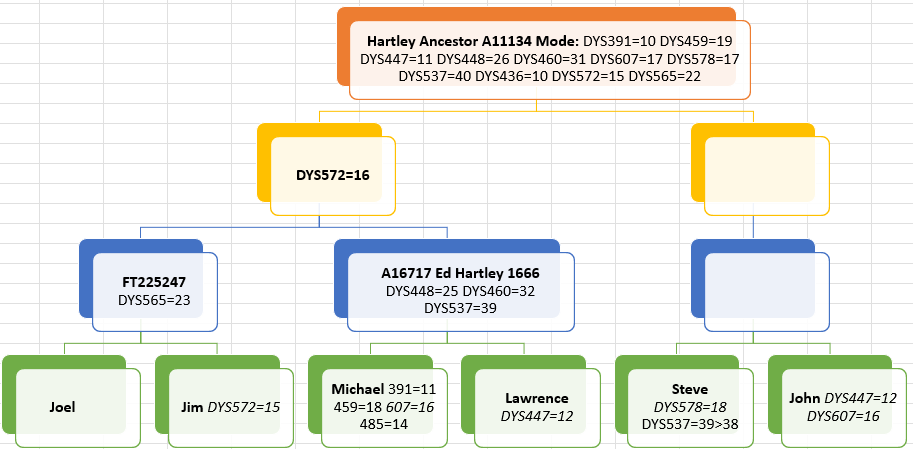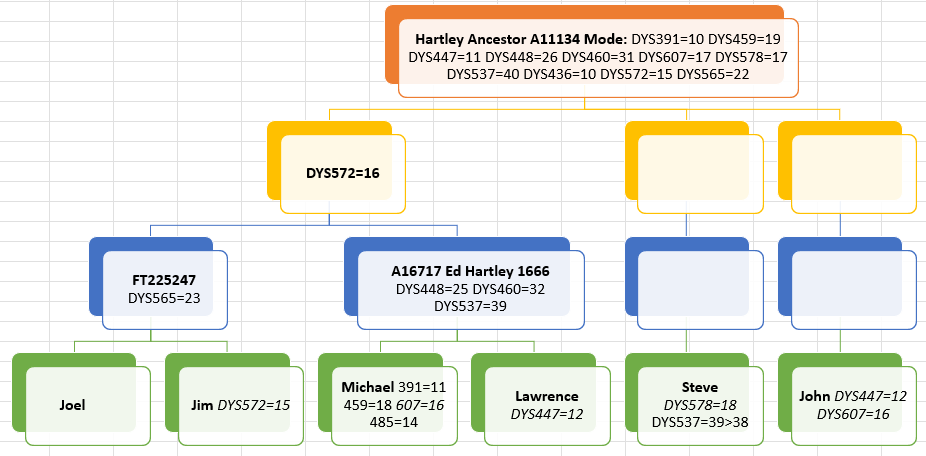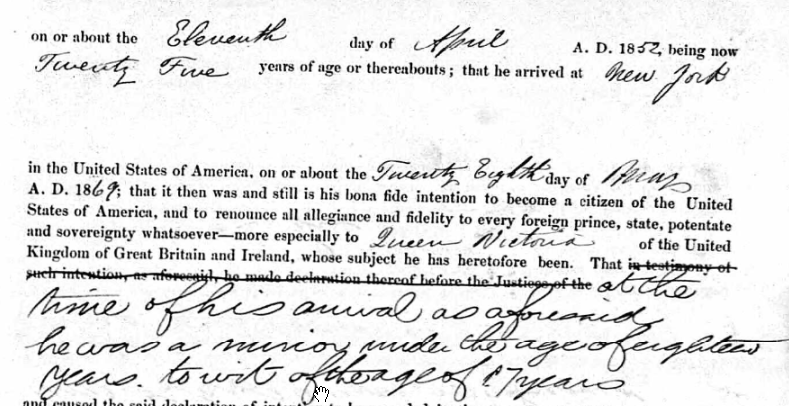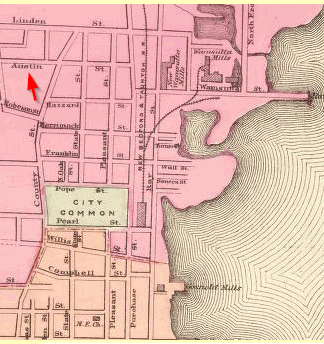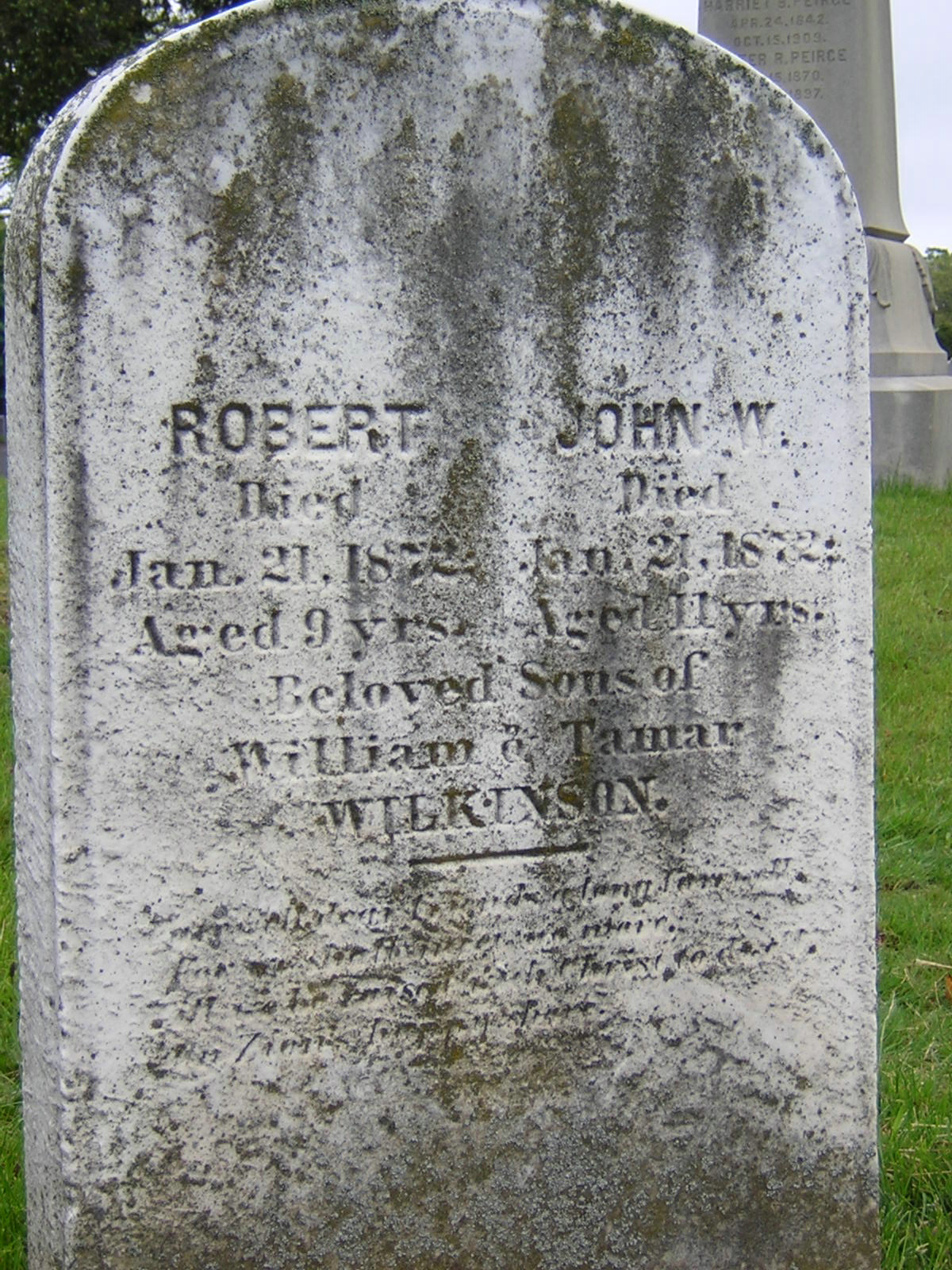I have been in touch with Michael who has ordered a BigY test. He has Nutter genealogy, but he appears to have a male YDNA Haplogroup that only Hartleys have held so far. I am interested how closely he is related to the Hartleys.
I see that Michael has this genealogy posted. I hope he doesn’t mind me taking a look at it.
I’ll start a Nutter tree at Anestry, to see if we come to the same conclusions.
Here is Albert or James A in the 1901 Census:
He lived in Hindley but was born in Tyldesley.
James Nutter 1847
Here is a tree from Ancestry:
Here is Abram – a village in Wigan:
James had two wives and James Albert was from the second wife. Here is a young James in the 1851 Census:
John Nutter 1817
James father John was a Boat Builder in Bedford in 1851. While snooping around Ancestry, I found a better Nutter tree from Michael – the one taking the BigY 700 test:
Interestingly for me, there is a Hartley Line there from 1749.
Here is John Nutter and family in 1861:
All these places were close to each other:
This appears to be the transcription for John’s marriage:
He was a ship carpenter which fits in to the Census records. Here is Haigh to the NE of Wigan:
This appears to be John’s baptismal record:
Here is some more local geography:
Richard Nutter
Here are a few choices for Richard Nutter:
Assuming these are the two best choices, let’s see which is the best choice.
Richard number one is a husbandman from Brindle. I think a husbandman is someone who takes care of animals. I looked it up and a quick result said farmer. I’m not sure of the difference between a yeoman and a husbandman. I looked yeoman up also and got:
a man holding and cultivating a small landed estate; a freeholder.
Here is Brindle:
Richard Nutter #2
This Richard was a house carpenter. This would seem more in line with his son John’s occupation of ship carpenter – though at the time of John’s birth, Richard was apparently a weaver.
This appears to be the Parish of Burton in Kendal:
By location, it appears that Richard #1 is better. Let’s see where they married:
This is what I get for Warton (above) though Lancaster seems further north. That makes the decision more difficult. Do we go by occupation or location?
I need to find Richard in the Census if possible. My thinking is that the Richard Nutter who had John Nutter in 1816 in Chanock hung around the area. His Census should have where he was born. Unfortunately, I could not find Richard easily in this area.
Taking a Look at Michael’s Tree
I see that Michael has this information for Richard Nutter:
If this is right, then Richard and Jane should appear in the Rivington Census of 1841 and Richard should appear in the 1851 Rivington Census. I also see that Michael has this Bishop’s Transcript marriage record:
Here Richard is a Servant rather than a husbandman.
This appears to be a record for Richard’s death:
Here is the burial record for Jane:
Here are some other records from Rivington:
Assuming this is the same couple (and they appear to be), this would represent perhaps moving out of the area for a while? Here is Adlington:
Actually Adlington is near Rivington. Here is Oswaldtwistle:
So not too far away if right.
Nutter Baptisms at Rivington Church
I don’t see a corresponding birth record for Jane Nutter who died in 1826. I see one record for ‘Margrit’s’ baptism as Jennett as the mother.
When James was born, Richard was a farmer:
Here is an early baptism at Rivington Church:
Here is another Nutter Burial:
If this Coln is Colne, then here is a connection to the area where my Hartleys came from. Here is a guess for the baptism of Mary:
I couldn’t easily find a marriage record for Henry Nutter around this time. Here are three marriages with the last being in Colne witnessed by a Hartley:
Also I see this baptismal record with a Henry and a Richard:
Here is a better connection:
Notice that even the abode of Coln is the same spelling as the abode of Coln in the burial record for Mary Nutter in Rivington, daughter of Henry Nutter. It would seem od for there to be two misspellings of Colne in twon different records relating to Nutter.
Here is one more record with that spelling:
If I put the three ‘Colns’ together, it looks like perhaps Henry and Sally Nutter had John Nutter in 1782 in Colne, Richard Nutter in 1787, then moved to Rivington at some point where they buried daughter Mary in 1802.
An Interesting Record for Richard Nutter
Here is the reference for the above document:
To me, it would be a coincidence if this is not the same Richard Nutter. Basically, Margaret Eccles had a male “bastard” child which had to be supported by the government. She calls out Richard Nutter who is required to give some support for the raising of the child.
Here is Yate and Pickup Bank:
So, I am learning a bit about local geography through this exercise.
Here is a baptism for a daughter of Peggy Eccles:
Here is another legal document concerning Richard:
Actually, I am not sure this is the same Richard as here is the location referred to in the 1830 document:
I’m spending a lot of time on Richard because he seems to be a crucial link to going further back in time in Nutter genealogy.
Richard Nutter in the Census
This appears to be the wrong Richard in 1841 Preston:
This appears to be the house carpenter who married Jane Nuttal. Here is the same family in 1851:
This Richard was born in Wennington.
I found this Jane in the 1841 Census, but I don’t know if she is the right person:
This Jane shows that she was not born in Lancashire.
Richard’s Father was Henry, John or Richard?
Ancestry suggests Richard as the father of Henry as their ‘hint’. Michael has John Nutter as the father of Richard:
As mentioned above, I am leaning toward Henry being the father of Richard. I’ll try putting Henry in the Private Ancestry Tree that I have made.
This appears to put me in the minority. I found three trees for Richard Nutter at Ancestry and they all show Richard for the father. Here is the couple I am going with:
I am guessing that this Henry could have been born around 1760. Here are some Baptisms from around that time:
My best guess for Henry is the last one. He was born in 1754, so would have been 27 when he married. The other two Henrys are from Burnley or Barrowford. Barrowford is outside of current Colne. Here is Colne Edge:
Apparently, I am in the minority with this Henry also. I looked at three trees for Henry and they show him having a son Richard, but the son who was born in Wennington. So, I am going in circles a bit. Even though I am going against other Ancestry trees, I think my logic in my connection between Rivington and Colne is sound.
Why Not Richard as the father of Richard?
I had mentioned above that there was a Richard Nutter in the Rivington Parish who lived in Rivington. He had a daughter Mary baptized there in 1768:

Could he have been the father of the Richard who lived in the Rivington area? It would seem possible, however, under that scenario, this Richard would have had Mary in Rivington and then gone back to Colne to have Richard and then somehow Richard would have made his way back to Rivington Parish. Plus, this birth was in 1768. I believe that Michael’s ancestor Richard was born in 1787 which was 20 years later.
Here is one Richard born to a Richard, but he appears to have died soon after his birth:
Here is the best guess for the Richard son of Richard scenario:
Unfortunately, the Rivington baptismal record for Mary did not mention the name of the mother.
Here are some marriages for Richard Nutter and Mary:
The first marriage would have been too early to have Richard in 1788. The second marriage would probably be too early to have Richard in 1788. Assuming this Mary was 20 at the time of marriage, 29 years later she would be 49 having Richard. I suppose this is a possible scenario, but not likely. Finally, the last Richard Nutter would be a good candidate to have the Richard Nutter born at Lawn in 1788, but not as likely to have Mary baptized in 1768 in Rivington.
Richard Nutter Born 1719
Ancestry has three trees which all look somewhat like this one:
As there were three Richard Nutters baptized in Colne in 1719, I wonder how they knew they had the right one?
The 24 January 1719/20 from Greater Marsden above is probably the one mentioned in the Ancestry Trees – though Ancestry has the birth in Trawden.
Here are a few more Richard Nutters in Lancashire:
If I had to guess I would probably go with the one from ‘Coln’ based on the spelling mentioned earlier. However, that is a guess. The name is spelled differently, but I’m sure there were spelling variations in the early 1700’s. I was hoping that there would be fewer Richard Nutters the further back I went, but there were more. So this would seem to be a good time to end this Blog. This is my best guess based on my limited research:
Summary and Conclusions
- I am interested in Michael’s ancestry because he has ordered a BigY Test which indentifies the male line. Michael’s past YDNA testing has put him in a branch of the male tree of mankind that has been reserved for Hartleys up to this point. Michael’s male only line ancestry is Nutter.
- The Nutter genealogy gets more difficult at the point of Richard Nutter. This is because it is difficult to find this Richard in the Census. According to the Quarter Sessions, this Richard appears to have fathered a boy with Margaret Eccles and was required to come up with support for the boy. There was also a Richard and Margaret Nutter mentioned in the Quarter Sessions. But I don’t know if this is Margaret Eccles above.
- Based on connections that Henry Nutter and his wife Sally had between Colne and Rivington Parish, it seemed like Henry would be a likely candidate to be the father of Richard. I went on that assumption which lead me to another Richard as Henry’s father. However, there were too many Richard’s born in the early 1700’s to identify which Richard he was.














































































































